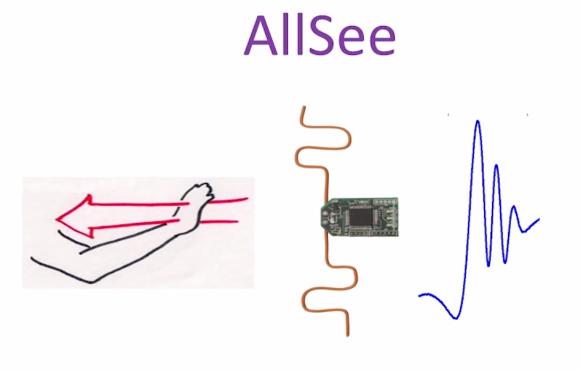A team at the University of Washington recently developed Allsee, a simple gesture recognition device composed of very few components. Contrary to conventional Doppler modules (like this one) that emit their own RF signal, Allsee uses already existing wireless signals (TV and RFID transmissions) to extract any movement that may occur in front of it.
Allsee’s receiver circuit uses a simple envelope detector to extract the amplitude information to feed it to a microcontroller Analog to Digital Converter (ADC). Each gesture will therefore produce a semi-unique footprint (see picture above). The footprint can be analyzed to launch a dedicated action on your computer/cellphone. The PDF article claims that the team achieved a 97% classification accuracy over a set of eight gestures.
Obviously the main advantage of this system is its low power consumption. A nice demonstration video is embedded after the break, and we’d like to think [Korbi] for tipping us about this story.















need it naw!!!
There was an old article about some system like this. Is it the same team that made this hack ?
I remember an artical about using backgroud radiation to see a “shadow” of stealth bombers.
Would it be possible to use this technology to “see” through walls? Let’s say the police need to know where a kidnapper is on the other side of the wall. Wouldn’t this be plausible with a similar technique, somehow?
hmmm, or the kidnapper could use it to see if the police is on the other side of the wall….
http://www.computerworld.com/s/article/9240429/MIT_researchers_can_see_through_walls_using_39_Wi_Vi_39_
this seems some what similar. I remember seeing one a while back that used normal wifi routers but maybe Im wrong or can’t find the link.
http://hackaday.com/2012/08/11/seeing-through-walls-using-wifi/
There was Norwegian company called Novelda that made small radar based boards…if I recall it right.
I’m not puttin’ that on my phone!
This is so awesome! It would be great to integrate it in phones.. But thats making people more lazy.. Ah
So maybe the hoky poky is what it’s all about…
RFID? Did they mean RF?
‘Please make sure you remain completely motionless at all times unless you wish to operate a device’
for future development possibilities see fringe
First I admit I haven’t really studied the PDF paper. As I read it that the hand gesture is amplitude modulating an available RF signal, that’s demodulated by a direct conversion radio receiver. To what degree are either made made and nature inference affect the gesture, what are the chances such interference will render a gesture unrecognizable or, mimic a valid gesture, if at all?
Sheet comment got sent without my commanding it to be. Before I stated I never read anything about modulating an existing RF signal with information before this.